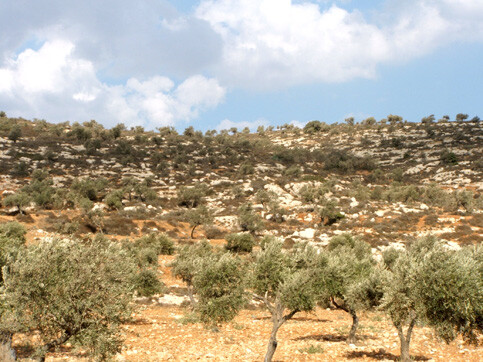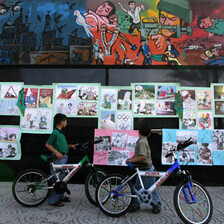
Palestine’s “vanishing landscape” (Maureen Clare Murphy)
For the past four decades I have been a passionate walker. For much of this time the hills northeast of Ramallah, my favorite wandering ground, were largely empty of settlements and I could walk freely, without constraint. However, this situation changed dramatically after Israel and the Palestine Liberation Organization (PLO) signed the Oslo Accords in 1993 and 1995. Since then, settlement activity has reached unprecedented levels, spreading in many cases over lands that are privately owned by Palestinians. Overall, the population of West Bank settlements increased by at least 40 percent between the signing of the Oslo Accords and the outbreak of the second Palestinian intifada in September 2000.
As the Israel-Palestine peace process flounders, aggressive behavior by Jewish settlers and their supporters in the Israeli army is making the countryside of the West Bank an increasingly dangerous place for Palestinians. Behind this development is the belief that there is no room in “Greater Israel” for the Palestinians. That it is either us or them.
Tragic examples of this trend are plentiful: On 23 December 2007, 32-year-old Firas Kaskas, visiting Ramallah from his village near Bethlehem in order to see his brother-in-law’s new house, just down the road from my own, was shot dead as he took an afternoon stroll in the Ramallah hills. Five months later, 20-year-old Rashad Khader was also killed, this time while hunting birds with a group of Palestinian friends. Drivers on the Ramallah-Tulkaram Road have reported several incidents of the stoning of their cars by settlers and in some instances shooting of live fire as well.
Aware of the dangers now facing hikers like me, I have, of late, been careful to restrict my walks to tracks which avoid any contact with the settlements. Two recent incidents that I have experienced personally and which, I believe, illustrate what routine life is now like for us Palestinians in the occupied territories:
The first occurred last month during a walk in the countryside near my home. I was walking with a BBC journalist who had come to interview me about my new book. We had reached the village of A’yn Qenya where we intended to end our expedition when we were stopped by two settlers from nearby Dolev in a car parked by the side of the road. The driver wore a knitted skullcap; next to him sat a younger man with the side locks worn by ultra-religious Jews. The driver rolled down his window and asked:
“Who are you?”
I thought he might have mistaken us for Israelis who had lost their way and needed assistance.
To re-assure them I said: “I live near here.”
“What are you doing here?”
“Taking a walk.”
“Where did you come from?”
“Ramallah,” I said and added, “just up the hill.”
My journalist companion held out his microphone towards the man.
“You are recording me?” He asked defiantly.
“I’m a journalist,” the BBC man replied.
“Show me your identity card,” the settler demanded, pointing at me.
There was a pause as we tried to figure our how to respond to the audacity of this civilian acting as an investigator.
I leaned towards him and asked:
“Who are you?”
“I’m no one.”
“Do you have an identity card?”
The settler changed tactics saying: “I don’t need your card, I’m calling the army.” And he proceeded to take out his mobile phone and begin to dial.
“Why are you here?” I asked.
He looked me in the eye: “I’m different from you,” he said “I’m living here, really living here, not like you.”
The second incident took place just a week later. I was awakened in the early hours of the morning by my neighbor, Vera Tamari, an artist who lives by herself. She informed me that Israeli soldiers had just forced their way into her house in the middle of the night. Ignoring her protests, they had insisted on searching each and every room, questioning her about all sots of private matters, including photos of her nieces, and, most disturbingly drawing a detailed plan of her house. They then proceeded to do the same in every other house of the neighborhood that looked out on the Jewish settlements occupying the facing hills. There was no apology for this intrusion, nor any explanation. The soldiers stayed for some three hours and then left as quickly as they had arrived.
Under the Oslo Accords, the Israeli army is prohibited from entering Ramallah, which is under the full territorial jurisdiction of the Palestinian Authority. The only exceptions allowed are instances when the army is in hot pursuit of people threatening life or property. Clearly this was not the case in their searching of my neighbor’s house. The Israelis were deliberately violating an agreement signed with the PLO, presumably to help protect the nearby settlements — settlements deliberately built to undermine peace and in violation of international and even Israeli law.
For example, Talmon, northeast of Dolev, was established in 1989 on lands from the nearby Palestinian village of Janiyeh. Illegal itself under international law, it has given birth to Talmon B — deliberately set up in 1992 to undermine peace negotiations and Talmon C — violating Israeli commitments under the Oslo Accords not to build new settlements. In circumvention, both are described by settlers as “new neighborhoods.” There is even a Talmon C West, an “outpost” illegal by Israeli law and government policy.
Yet nothing has been done to remove at least twelve such illegal outposts in the Ramallah area, let alone the 40 percent of Israeli settlement acknowledged by the Israeli government to be on private Palestinian land. Such daily examples of grotesque asymmetry in applying the rule of law makes it increasingly difficult for many Palestinian to see law itself as a path to justice.
Back to the settler who stopped me and the BBC reporter. I asked the settler what he meant when he said that, unlike me, “He really lived here” but he would not explain himself. Instead he rolled up his window and proceeded to summon the army on his cell phone. When we went to leave, he tried to block our way with his car. I knew that if we hung around until the army arrived we could easily be detained for hours. The soldiers would surely take the side of the settler against a Palestinian. And so I told my companion to join me in jumping on a minibus that was parked nearby and which would take us back to Ramallah. As I sat on the bus I reflected on another walk ruined and wondered when further restrictions on my life in the occupied West Bank would make it impossible for me “to really live here.”
Raja Shehadeh is a land rights lawyer who lives in Ramallah and is the author of Palestinian Walks: Forays into a Vanishing Landscape, which won the Orwell Prize for 2008. The book is published by Scribner.





